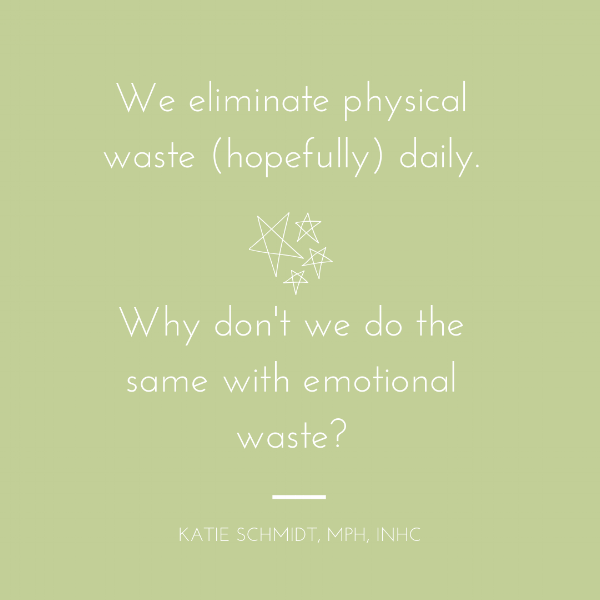How to Strengthen the Mind-Body Connection in Daily Life
Eliminating Emotional Waste
It’s feels good to start a fresh week with a clear head and new energy. The success of which greatly rides on our ability to prioritize sleep, nutrition, movement and manage emotional energy. But it’s this last area, our emotional energy, we often neglect.
When we hold in, resist, or ruminate over the same thoughts and emotions day after day, they can have a devastating impact on our psyche, perspectives, sense of self, and physical state (e.g. immune, digestive & hormone health). This is the mind-body connection at work; the state of our mind impacts our physical body and vice versa.
When my clients bring up cravings, binge eating, or other challenges with food, there’s often a mental component where they're not expressing their true emotions. So often they don’t have a place to set them; somewhere safe, somewhere secure, somewhere OUTSIDE their body. This happens to a lot of us -- and we end up literally eating and stuffing down our emotions.
So, here’s my question to you:
We eliminate physical waste (hopefully) daily. Why don’t we do the same with emotional waste?
My theory is this: It’s not that we can't find 5-10 minutes to attend to our emotions. It's that, like so many food and lifestyle habits:
We haven't identified our WHY — our deeper desire for doing the activity — or discovered how it aligns with our health values.
We don’t know which tools to use nor do we have the structure or routine in place to support the activity; the designated time of day, the go-to chair, the pen and paper set up ready and waiting.
Keep reading to understand the WHY — why this work of eliminating emotional waste is important — and to learn a few real-life tactical tools for practicing.
Why should I care about eliminating emotional waste?
Transferring our thoughts onto paper creates a physical distance between the thoughts and our body/mind. Having a healthy distance allows us to observe the thoughts more objectively, rather than get caught up in them, which in turn allows the intensity of the emotion to dissipate over time.
Writing down our thoughts, ideas, emotions, and fears is like skimming the foam off a pot of boiling pasta. Once the foam is removed we see the water more clearly and there’s more space in the pot for new bubbles to surface without the water boiling over. By removing the foam of old, reoccurring thoughts we gain clarity and free up prime mental real estate for new insights to emerge.
Practical tools for eliminating emotional waste
This week be good to your whole self. Support your physical health and a sense of ease in your body by taking a small step to acknowledge your mental and emotional health. Get out your calendar and carve out 5-10 minutes in your day to release emotional waste. Then locate or purchase a journal or notebook and a good pen, and place them at your preferred seat so they're ready when you are.
Below are a few tools to get you started. Choose one activity for the 5-10 minute block.
Use the pictured book, Let It Out, for excellent writing prompts
Download the app, Insight Timer, for quality meditations
Write Stream of Consciousness style (e.g. freestyle). Dump onto the page all the thoughts, ideas, inspiration, anxieties, and frustrations circling in your head. It doesn’t have to flow, it doesn’t have to look pretty. Just get it out.
Read a few pages of an inspirational book, such as The Daily Stoic, The Art of Stillness, The Hero's Journey, or the Artist’s Journey, and write your thoughts afterward.
Final thoughts
Simply commit to practicing just one day to start. See how it feels in the moment and notice the effect it has on you, your emotions, focus, and energy as you go about your day. Then return to your calendar and carve out another 5-10 minute block this week. Eventually you’ll find your own weekly rhythm that feels right. There may be times you want to do it daily, other times just a few times per week.











